第九讲 修辞格的翻译2
- 格式:ppt
- 大小:476.00 KB
- 文档页数:41
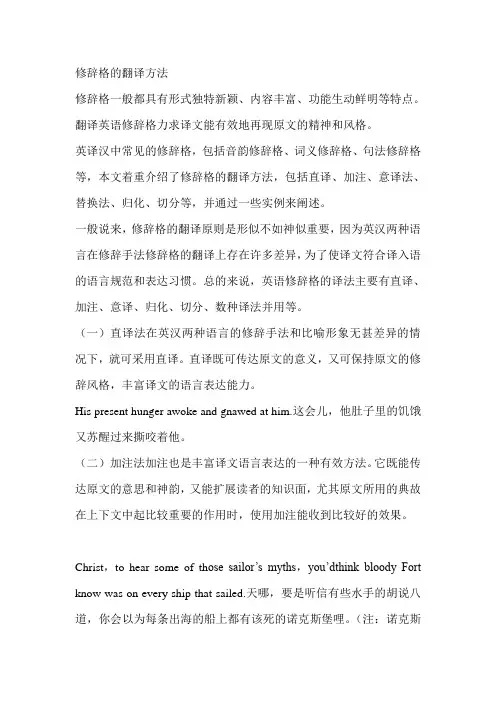
修辞格的翻译方法修辞格一般都具有形式独特新颖、内容丰富、功能生动鲜明等特点。
翻译英语修辞格力求译文能有效地再现原文的精神和风格。
英译汉中常见的修辞格,包括音韵修辞格、词义修辞格、句法修辞格等,本文着重介绍了修辞格的翻译方法,包括直译、加注、意译法、替换法、归化、切分等,并通过一些实例来阐述。
一般说来,修辞格的翻译原则是形似不如神似重要,因为英汉两种语言在修辞手法修辞格的翻译上存在许多差异,为了使译文符合译入语的语言规范和表达习惯。
总的来说,英语修辞格的译法主要有直译、加注、意译、归化、切分、数种译法并用等。
(一)直译法在英汉两种语言的修辞手法和比喻形象无甚差异的情况下,就可采用直译。
直译既可传达原文的意义,又可保持原文的修辞风格,丰富译文的语言表达能力。
His present hunger awoke and gnawed at him.这会儿,他肚子里的饥饿又苏醒过来撕咬着他。
(二)加注法加注也是丰富译文语言表达的一种有效方法。
它既能传达原文的意思和神韵,又能扩展读者的知识面,尤其原文所用的典故在上下文中起比较重要的作用时,使用加注能收到比较好的效果。
Christ,to hear some of th ose sailor’s myths,you’dthink bloody Fort know was on every ship that sailed.天哪,要是听信有些水手的胡说八道,你会以为每条出海的船上都有该死的诺克斯堡哩。
(注:诺克斯堡是美国一个军事保留地,是美国黄金仓库的所在地。
)(三)意译法由于许多英语修辞手法或比喻形象本身是特有的,如保留其形象就会危害其义。
如英语的头韵法,其搭配可以千变万化,很难碰巧找到这样的汉语搭配,即使勉强凑韵,也不一定能表达原文的意思。
在这种情况下,必须首先保证译文能正确传达原文的思想内容,然后尽一切可能去表现原文的节奏和旋律。
safe and sound安然无恙now and never机不可失(1)He is the mouth of the House in its relations with the crown.他是议会对王室的发言人。
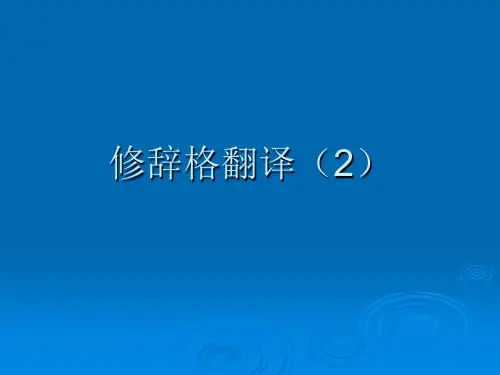
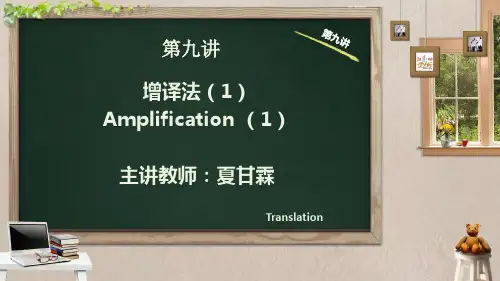
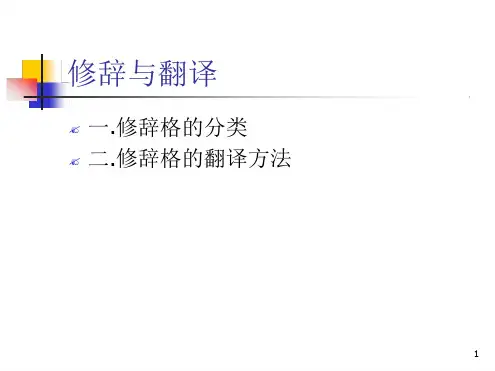
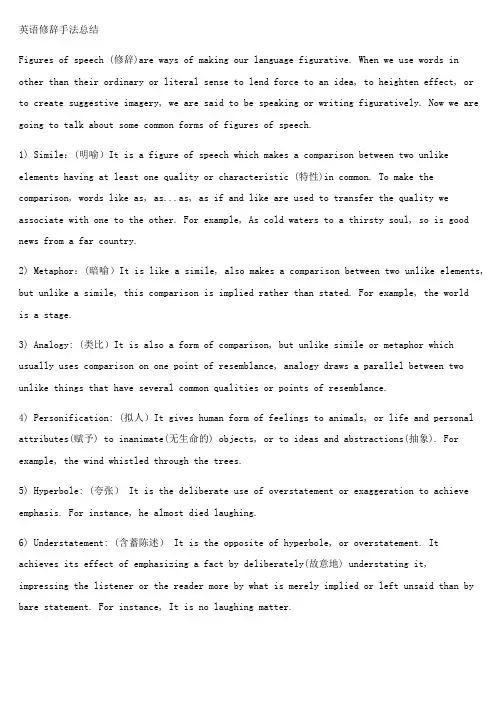
英语修辞手法总结Figures of speech (修辞)are ways of making our language figurative. When we use words in other than their ordinary or literal sense to lend force to an idea, to heighten effect, orto create suggestive imagery, we are said to be speaking or writing figuratively. Now we are going to talk about some common forms of figures of speech.1) Simile:(明喻)It is a figure of speech which makes a comparison between two unlike elements having at least one quality or characteristic (特性)in common. To make the comparison, words like as, as...as, as if and like are used to transfer the quality we associate with one to the other. For example, As cold waters to a thirsty soul, so is good news from a far country.2) Metaphor:(暗喻)It is like a simile, also makes a comparison between two unlike elements, but unlike a simile, this comparison is implied rather than stated. For example, the worldis a stage.3) Analogy: (类比)It is also a form of comparison, but unlike simile or metaphor which usually uses comparison on one point of resemblance, analogy draws a parallel between two unlike things that have several common qualities or points of resemblance.4) Personification: (拟人)It gives human form of feelings to animals, or life and personal attributes(赋予) to inanimate(无生命的) objects, or to ideas and abstractions(抽象). For example, the wind whistled through the trees.5) Hyperbole: (夸张) It is the deliberate use of overstatement or exaggeration to achieve emphasis. For instance, he almost died laughing.6) Understatement: (含蓄陈述) It is the opposite of hyperbole, or overstatement. Itachieves its effect of emphasizing a fact by deliberately(故意地) understating it,impressing the listener or the reader more by what is merely implied or left unsaid than by bare statement. For instance, It is no laughing matter.7) Euphemism: (委婉) It is the substitution of an agreeable or inoffensive(无冒犯) expression for one that may offend or suggest something unpleasant. For instance, we refer to "die" as " pass away".8) Metonymy (转喻)It is a figure of speech that has to do with the substitution of the mane of one thing for that of another. For instance, the pen (words) is mightier than the sword (forces).9) Synecdoche (提喻) It is involves the substitution of the part for the whole, or thewhole for the part. For instance, they say there's bread and work for all. She was dressedin silks.10) Antonomasia (换喻)It has also to do with substitution. It is not often mentioned now, though it is still in frequent use. For example, Solomon for a wise man. Daniel for a wise and fair judge. Judas for a traitor.11) Pun: (双关语) It is a play on words, or rather a play on the form and meaning of words. For instance, a cannon-ball took off his legs, so he laid down his arms. (Here "arms" has two meanings: a person's body; weapons carried by a soldier.)12) Syllepsis: (一语双叙) It has two connotations.In the first case, it is a figure by which a word, or a particular form or inflection of a word, refers to two or more words in the same sentence, while properly applying to or agreeing with only on of them in grammar or syntax(句法). For example, He addressed you and me, and desired us to follow him. (Here us is used to refer to you and me.)In the second case, it a word may refer to two or more words in the same sentence. For example, while he was fighting , and losing limb and mind, and dying, others stayed behind to pursue education and career. (Here to losing one's limbs in literal; to lose one's mindis figurative, and means to go mad.)13) Zeugma: (轭式搭配) It is a single word which is made to modify or to govern two or more words in the same sentence, wither properly applying in sense to only one of them, orapplying to them in different senses. For example, The sun shall not burn you by day, nor the moon by night. (Here noon is not strong enough to burn)14) Irony: (反语) It is a figure of speech that achieves emphasis by saying the opposite of what is meant, the intended meaning of the words being the opposite of their usual sense. For instance, we are lucky, what you said makes me feel real good.15) Innuendo: (暗讽) It is a mild form of irony, hinting in a rather roundabout (曲折)way at something disparaging(不一致) or uncomplimentary(不赞美) to the person or subject mentioned. For example, the weatherman said it would be worm. He must take his readings in a bathroom.16) Sarcasm: (讽刺) It Sarcasm is a strong form of irony. It attacks in a taunting and bitter manner, and its aim is to disparage, ridicule and wound the feelings of the subject attacked. For example, laws are like cobwebs, which may catch small flies, but let wasps break through.17) Paradox: (似非而是的隽语) It is a figure of speech consisting of a statement or proposition which on the face of it seems self-contradictory, absurd or contrary to established fact or practice, but which on further thinking and study may prove to be true, well-founded, and even to contain a succinct point. For example more haste, less speed.18) Oxymoron: (矛盾修饰) It is a compressed paradox, formed by the conjoining(结合) of two contrasting, contradictory or incongruous(不协调) terms as in bitter-sweet memories, orderly chaos(混乱) and proud humility(侮辱).19) Antithesis: (对照) It is the deliberate arrangement of contrasting words or ideas in balanced structural forms to achieve emphasis. For example, speech is silver; silence is golden.20) Epigram: (警句) It states a simple truth pithily(有利地) and pungently(强烈地). It is usually terse and arouses interest and surprise by its deep insight into certain aspects of human behavior or feeling. For instance, Few, save the poor, feel for the poor.21) Climax: (渐进) It is derived from the Greek word for "ladder" and implies the progression of thought at a uniform or almost uniform rate of significance or intensity,like the steps of a ladder ascending evenly. For example, I came, I saw, I conquered.22) Anti-climax or bathos: (突降)It is the opposite of Climax. It involves stating one's thoughts in a descending order of significance or intensity, from strong to weak, from weighty to light or frivolous. For instance, But thousands die, without or this or that, die, and endow(赋予) a college, or a cat.23) Apostrophe: (顿呼) In this figure of speech, a thing, place, idea or person (dead or absent) is addressed as if present, listening and understanding what is being said. For instance, England! awake! awake! awake!24) Transferred Epithet: (转类形容词) It is a figure of speech where an epithet (anadjective or descriptive phrase) is transferred from the noun it should rightly modify(修饰) to another to which it does not really apply or belong. For instance, I spent sleeplessnights on my project.25) Alliteration: (头韵) It has to do with the sound rather than the sense of words for effect. It is a device that repeats the same sound at frequent intervals(间隔) and since the sound repeated is usually the initial consonant sound, it is also called "front rhyme". For instance, the fair breeze blew, the white foam flew, the furrow followed free.26) Onomatopoeia: (拟声) It is a device that uses words which imitate the sounds made by an object (animate or inanimate), or which are associated with or suggestive(提示的) of some action or movementExplanation version1一、什么是修辞格修辞格(figures of speech)是提高语言表达效果的语言艺术。
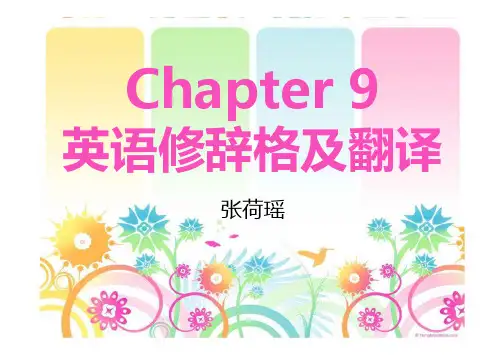
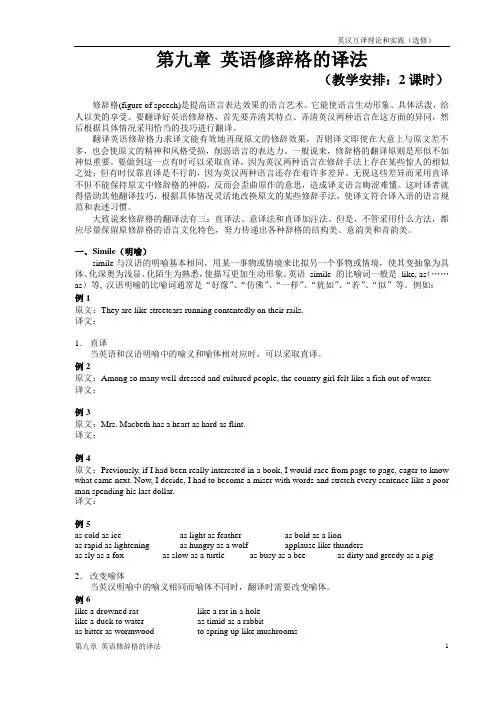
第九章英语修辞格的译法(教学安排:2课时)修辞格(figure of speech)是提高语言表达效果的语言艺术。
它能使语言生动形象、具体活泼,给人以美的享受。
要翻译好英语修辞格,首先要弄清其特点、弄清英汉两种语言在这方面的异同,然后根据具体情况采用恰当的技巧进行翻译。
翻译英语修辞格力求译文能有效地再现原文的修辞效果,否则译文即使在大意上与原文差不多,也会使原文的精神和风格受损,削弱语言的表达力。
一般说来,修辞格的翻译原则是形似不如神似重要。
要做到这一点有时可以采取直译,因为英汉两种语言在修辞手法上存在某些惊人的相似之处;但有时仅靠直译是不行的,因为英汉两种语言还存在着许多差异。
无视这些差异而采用直译不但不能保持原文中修辞格的神韵,反而会歪曲原作的意思,造成译文语言晦涩难懂。
这时译者就得借助其他翻译技巧,根据具体情况灵活地改换原文的某些修辞手法,使译文符合译入语的语言规范和表述习惯。
大致说来修辞格的翻译法有三:直译法、意译法和直译加注法。
但是,不管采用什么方法,都应尽量保留原修辞格的语言文化特色,努力传递出各种辞格的结构美、意韵美和音韵美。
一、Simile(明喻)simile与汉语的明喻基本相同,用某一事物或情境来比拟另一个事物或情境,使其变抽象为具体、化深奥为浅显、化陌生为熟悉,使描写更加生动形象。
英语simile 的比喻词一般是like, as(……as)等, 汉语明喻的比喻词通常是“好像”、“仿佛”、“一样”、“犹如”、“若”、“似”等。
例如:例1原文:They are like streetcars running contentedly on their rails.译文:1.直译当英语和汉语明喻中的喻义和喻体相对应时,可以采取直译。
例2原文:Among so many well-dressed and cultured people, the country girl felt like a fish out of water.译文:例3原文:Mrs. Macbeth has a heart as hard as flint.译文:例4原文:Previously, if I had been really interested in a book, I would race from page to page, eager to know what came next. Now, I decide, I had to become a miser with words and stretch every sentence like a poor man spending his last dollar.译文:例5as cold as ice as light as feather as bold as a lionas rapid as lightening as hungry as a wolf applause like thundersas sly as a fox as slow as a turtle as busy as a bee as dirty and greedy as a pig 2.改变喻体当英汉明喻中的喻义相同而喻体不同时,翻译时需要改变喻体。
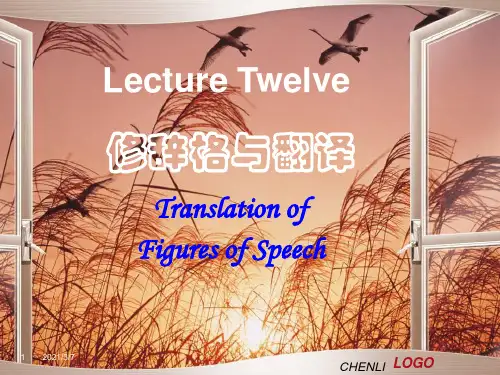


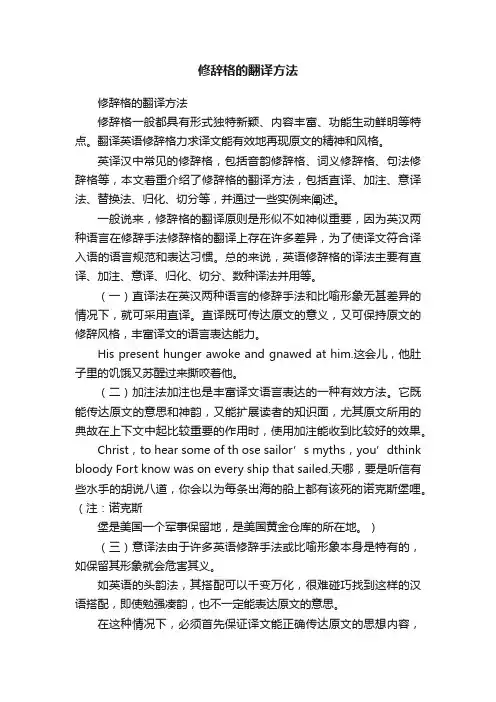
修辞格的翻译方法修辞格的翻译方法修辞格一般都具有形式独特新颖、内容丰富、功能生动鲜明等特点。
翻译英语修辞格力求译文能有效地再现原文的精神和风格。
英译汉中常见的修辞格,包括音韵修辞格、词义修辞格、句法修辞格等,本文着重介绍了修辞格的翻译方法,包括直译、加注、意译法、替换法、归化、切分等,并通过一些实例来阐述。
一般说来,修辞格的翻译原则是形似不如神似重要,因为英汉两种语言在修辞手法修辞格的翻译上存在许多差异,为了使译文符合译入语的语言规范和表达习惯。
总的来说,英语修辞格的译法主要有直译、加注、意译、归化、切分、数种译法并用等。
(一)直译法在英汉两种语言的修辞手法和比喻形象无甚差异的情况下,就可采用直译。
直译既可传达原文的意义,又可保持原文的修辞风格,丰富译文的语言表达能力。
His present hunger awoke and gnawed at him.这会儿,他肚子里的饥饿又苏醒过来撕咬着他。
(二)加注法加注也是丰富译文语言表达的一种有效方法。
它既能传达原文的意思和神韵,又能扩展读者的知识面,尤其原文所用的典故在上下文中起比较重要的作用时,使用加注能收到比较好的效果。
Christ,to hear some of th ose sailor’s myths,you’dthink bloody Fort know was on every ship that sailed.天哪,要是听信有些水手的胡说八道,你会以为每条出海的船上都有该死的诺克斯堡哩。
(注:诺克斯堡是美国一个军事保留地,是美国黄金仓库的所在地。
)(三)意译法由于许多英语修辞手法或比喻形象本身是特有的,如保留其形象就会危害其义。
如英语的头韵法,其搭配可以千变万化,很难碰巧找到这样的汉语搭配,即使勉强凑韵,也不一定能表达原文的意思。
在这种情况下,必须首先保证译文能正确传达原文的思想内容,然后尽一切可能去表现原文的节奏和旋律。
safe and sound安然无恙now and never机不可失(1)He is the mouth of the House in its relations with the crown.他是议会对王室的发言人。